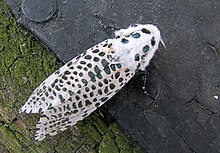Species of moth
| Leopard moth
|

|
| Upperside
|

|
| Lateral view
|
Scientific classification 
|
| Domain:
|
Eukaryota
|
| Kingdom:
|
Animalia
|
| Phylum:
|
Arthropoda
|
| Class:
|
Insecta
|
| Order:
|
Lepidoptera
|
| Family:
|
Cossidae
|
| Genus:
|
Zeuzera
|
| Species:
|
Z. pyrina
|
| Binomial name
|
Zeuzera pyrina
|
| Synonyms[1]
|
- Phalaena pyrina Linnaeus, 1761
- Phalaena aesculi Linnaeus, 1767
- Zeuzera decipiens Kirby, 1892
- Noctua hypocasstani Poda, 1761
- Zeuzera hypocastrina Dyar, 1902
- Phalaena hilaris Geoffroy in Fourcroy, 1785
- Zeuzera octopunctata Boisduval, [1841]
- Zeuzera pirina Staudinger, 1879
- Zeuzera esculi Staudinger, 1895
- Zeuzera pyrina ab. conflua Schultz, 1905
- Zeuzera yprina Stichel, 1918
- Zeuzera yprina f. paulomaculata Stichel, 1918
- Zeuzera pyrina ab. confluens Cockayne, 1955
- Zeuzera pyrina f. marginestriata Lempke, 1961
- Zeuzera pyrinia El-Hariri, 1968
|
Zeuzera pyrina, the leopard moth or wood leopard moth, is a moth of the family Cossidae.[2]
It is considered a pest by fruit growers, as the larvae feed on branches of many kinds of fruit trees (see list below). Olive trees in particular are very susceptible and can be killed by the larvae burrowing within them.
Subspecies
Subspecies include:[3]
- Zeuzera pyrina biebingeri W. & A. Speidel, 1986
- Zeuzera pyrina pyrina (Linnaeus 1761)
Zeuzera biebingeri is treated as a subspecies of Z. pyrina by some sources, but is mostly treated as a valid species.[4]
Distribution
This species can be found primarily in Europe (excluding Ireland)[5] but also in northern Africa (Algeria, Egypt, Libya, Morocco) and Asia (Taiwan, India, Iran, Iraq, Israel, Japan, Korea, Lebanon, Sri Lanka, Syria, Turkey). It was introduced into the northeastern United States prior to 1879 and has a range extending from Maine, Pennsylvania, Tennessee and Texas.[3][6]
Habitat
These moths are associated with woodland, gardens and orchards.[7]
Description
Zeuzera pyrina has a wingspan of 35–60 mm.[7] This is a highly distinctive species. The male is slightly smaller than the female. The length of the abdomen of the female is about 45–50 mm. These moths have a white head, with a black forehead and a very furry white thorax marked with six black spots. The abdomen is black, with short white hair-like scales on the posterior edge of each segment and a flat brush of scales on the apex. Forewings are whitish, long and narrow, with numerous black spots or black spots with white interior spots, arranged in rows along the veins. Hindwings are translucent, except in the anal area, with small black spots. In addition to the dimensions, the two sexes differ in the shape of the antennas, thinner in the female, while in the male they are markedly bipectinate, with the exception of terminals articles.
Biology
The moth flies from June to September depending on the location. The caterpillars are xylophagous. They feed on the wood of various deciduous trees and shrubs[7] (see list below), feeding internally for two or three years in the stems and branches before emerging to pupate under the bark. It can be a pest of fruit production.[8]





